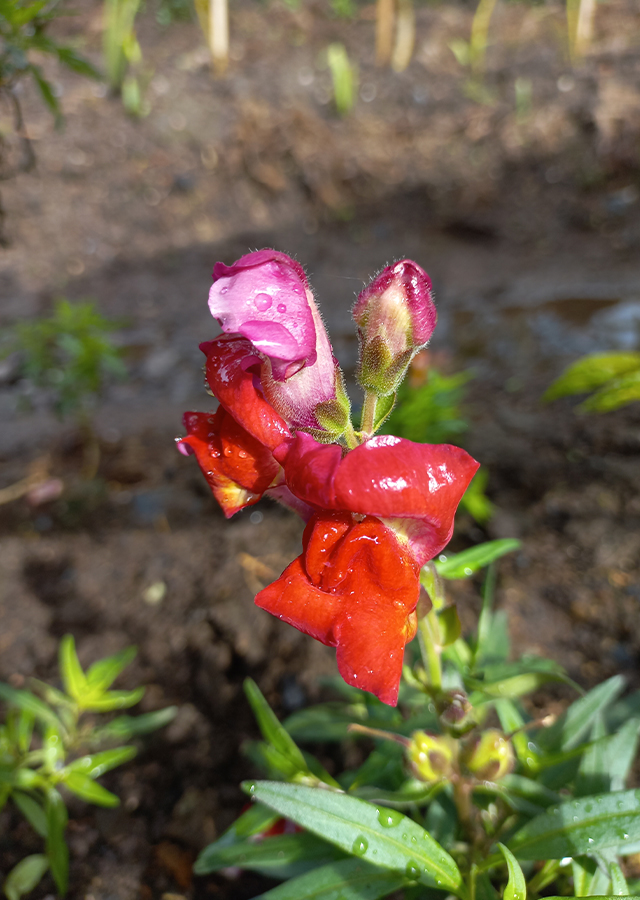Snapdragon
Antirrhinum majus L.
Plantaginaceae
Location in our garden
Principal



Synonym
Orontium majus (L.) Pers.
Termontis racemosa Raf.
Habitus
Herbaceous. An erect annual or short-lived perennial plant growing from 20-100 cm tall.
Part Used
Leaves
Flowers
The Whole Plant
Growing Requirements
Full Sunshine
Habitat
Forest
Rocky Areas
Terrestrial
Overview
Antirrhinum majus is native to Baleares, France, Portugal, and Spain. It holds a significant place in European folklore. Snapdragons have been considered, since antiquity, to possess magical qualities. The plant is sometimes harvested for local medicinal use. It is commonly grown as an ornamental in gardens, valued for its long-lasting floral display. Snapdragon tea has been used as a remedy for sore throat. The oil of snapdragon leaves is edible and is said to be just as healthy as olive oil. It has been extracted in Russia for culinary use since the 15th century. A green dye is obtained from the flowers, it does not require a mordant. Dark green and gold can also be obtained if a mordant is used. The fibre of the stem is tenacious and can be used as a textile.
Vernacular Names
Boca De Dragon (Spanish), Muflier (French), Kynokephelon (Greek), Bocca de leone (Italian), Lowenmaul (German), Grote Leeuwebek (Dutch), Leeuwenbek (Afrikaans), Jīnyú cǎo (Chinese), Boca-De-Leão (Brazil), Ajagar ka chitr (Hindi).
Agroecology
Growing in disturbed areas, woodlands, scrublands and on hard rock outcrops, old walls, rocks and dry places. Snapdragon thrives best in well-drained, moist, organic-rich, slightly acid soil in full sun. They are intolerant of subzero freezing temperatures and overwatering.
Morphology
- Stem - erect, tall, fleshy.
- Leaves - spirally arranged, broadly lanceolate, 1–7 cm long and 2-2.5 cm broad. The upper glandular stalk is stalk-round, sometimes woody to the middle. The opposite leaves are simple, elliptic or ovate to broad-lanceolate, sometimes linear and usually bleak.
- Flower- zygomorphic, bisexual, produced in erect, 10–20 flowered terminal racemes, violet, red, pink, yellow, or white, 3.5–4.5 cm long with ovate bracts and on 2–5 mm pedicels. Each flower has a calyx of five equal pubescent lobes.
- Fruit - ovoid capsule 10–14 mm diameter shaped like a skull, containing numerous small seeds.
- Seed - small, 0.8–1.1 mm, oblong–ovoid, reticulate and black seeds.
Cultivation
- Generative propagation is by seed - surface sow early spring in a greenhouse. The seed usually germinates in 10-21 days at 18 °C. Cool nights assist germination. When large enough to handle, prick the seedlings out into individual pots and plant them out in the summer. The seed can also be sown in situ in mid summer and will produce larger and more floriferous plants the following summer.
- Vegetative propagation is by cuttings of half-ripe wood.
Chemical Constituents
Iridoid compounds (antirrhinoside, antirrhide, 5-glucosyl-antirrhinoside, linarioside), mucilage, gallic acid, pectin, resin, flavonoids (anthocyanidins, flavonols, flavones, aurones, flavanones and cinnamic acids), alkaloid, monoterpenes, chalcones, and many other compunds.
Traditional Medicinal Uses
- The leaves have bitter and stimulant properties, and have been used to treat stomach ulcers.
- Flowers infusion can be used to treat jaundice, though it is not as effective as other herbal remedies.
- The leaves and flowers can be made into an ointment for rashes and sunburns.
- Crushed flowers, mixed with almond oil and warmed, can be applied to the skin to treat sprains, strains, hemorrhoids, rashes, redness, and inflammation. This same concoction can provide relief for stiff muscles and aching backs.
- An infusion of the flowers and leaves can be gargled to treat sores and ulcers of the mouth.
- The plant can be used as a diuretic, a treatment for scurvy, liver disorders, tumors and as a detergent and astringent.
- Studies showed that Antirrhinum majus possessed antimicrobial, insecticidal, cytotoxic, antioxidant, central and peripheral nervous system effects, and many other biological activities.
Part Used
Reference Sources
- Al-Snafi, A. E. (2015). THE PHARMACOLOGICAL IMPORTANCE OF ANTIRRHINUM MAJUS- A REVIEW. Asian Journal of Pharmaceutical Science & Technology, 5(4): 313-320.
- Ebrary.net. (2021). Snapdragon. https://ebrary.net/28107/environment/snapdragon. 16-01-2022.
- Fern, Ken. (2021). Useful Temperate Plants Database: Antirrhinum majus. http://temperate.theferns.info/plant/Antirrhinum+majus. 16-01-2022.
- Health Benefits Times. (2021). Health benefits of Common Snapdragon. https://www.healthbenefitstimes.com/snapdragon/. 16-01-2022.
- Kew Royal Botanic Gardens. (2021). Antirrhinum majus L. https://powo.science.kew.org/taxon/urn:lsid:ipni.org:names:799180-1. 16-01-2022.


